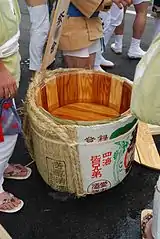Itako, Ibaraki
Itako (潮来市, Itako-shi) is a city located in Ibaraki Prefecture, Japan. As of 1 July 2020, the city had an estimated population of 27,577 in 10,849 households and a population density of 386 persons per km². The percentage of the population aged over 65 was 32.9%.[1] The total area of the city is 71.40 square kilometres (27.57 sq mi). It is known for its annual iris festival (Itako Ayame Matsuri). Much of the city is within the borders of the Suigo-Tsukuba Quasi-National Park.
Itako
潮来市 | |
|---|---|
 Maekawa Iris Park | |
 Flag  Seal | |
 Location of Itako in Ibaraki Prefecture | |
 Itako | |
| Coordinates: 35°56′49.7″N 140°33′19.3″E | |
| Country | Japan |
| Region | Kantō |
| Prefecture | Ibaraki |
| Area | |
| • Total | 71.40 km2 (27.57 sq mi) |
| Population (October 2020) | |
| • Total | 27,512 |
| • Density | 390/km2 (1,000/sq mi) |
| Time zone | UTC+9 (Japan Standard Time) |
| Symbols | |
| • Tree | Populus |
| • Flower | Iris |
| • Bird | Great reed warbler |
| Phone number | 0299-23-1111 |
| Address | 626 Tsuji, Itako-shi, Ibaraki-ken 311-2493 |
| Website | Official website |

Geography
Itako is located in southern Ibaraki Prefecture, bordered by Chiba Prefecture to the south, and sandwiched between Lake Kasumigaura to the west and Lake Kitaura to the east. The Tone River also flows through the city, which has been noted since the Edo period for its network of canals. The city is approximately 80 kilometers north of Tokyo.
Surrounding municipalities
Ibaraki Prefecture
Chiba Prefecture
Climate
Itako has a Humid continental climate (Köppen Cfa) characterized by warm summers and cool winters with light snowfall. The average annual temperature in Itako is 14.5 °C. The average annual rainfall is 1455 mm with September as the wettest month. The temperatures are highest on average in August, at around 25.9 °C, and lowest in January, at around 4.3 °C.[2]
Demographics
Per Japanese census data,[3] the population of Itako peaked around the year 2000 and has declined slightly since.
| Year | Pop. | ±% |
|---|---|---|
| 1920 | 17,385 | — |
| 1930 | 18,453 | +6.1% |
| 1940 | 20,007 | +8.4% |
| 1950 | 25,516 | +27.5% |
| 1960 | 24,467 | −4.1% |
| 1970 | 25,005 | +2.2% |
| 1980 | 29,075 | +16.3% |
| 1990 | 30,863 | +6.1% |
| 2000 | 31,944 | +3.5% |
| 2010 | 30,534 | −4.4% |
| 2020 | 27,604 | −9.6% |
History
The town of Itako was established within Namegata District with the creation of the modern municipalities system on April 1, 1889. Itako merged with the neighboring villages of Tsuwa, Nobukata and Ouhara on February 11, 1955. It was raised to city status on April 1, 2001, by absorbing the town of Ushibori.[4]
Government
Itako has a mayor-council form of government with a directly elected mayor and a unicameral city council of 16 members. Itako contributes one member to the Ibaraki Prefectural Assembly. In terms of national politics, the city is part of Ibaraki 2nd district of the lower house of the Diet of Japan.
Education
Itako has six public elementary schools and four public middle schools operated by the city government, and one public high school operated by the Ibaraki Prefectural Board of Education.
Transportation
Highway
Local attractions
- Suigo Itako Iris Gardens
- Junikyo Bridges
- Kongenyama park
- Nihonmatsu-dera Buddhist temple
- Inariyama Park
- Chōshō-ji Buddhist temple
- Suigo Hokusai Park
- Road Station Itako
- Suigo Dragonfly Park
Notable people from Itako
- Kenji Koyano, professional football player
- Keita Sugimoto, professional football player
- Tatsuya Kawahara, professional football player
- Mitsuo Yanagimachi, movie director
References
- "Ibaraki prefectural official statistics" (in Japanese). Japan.
- Itako climate data
- Itako population statistics
- 潮来市の沿革. Itako official website (in Japanese). Itako City. Archived from the original on October 31, 2011. Retrieved October 30, 2011.
- "Sake Enjoyed with Friends". chopsticksny.com. Retrieved March 30, 2023.
